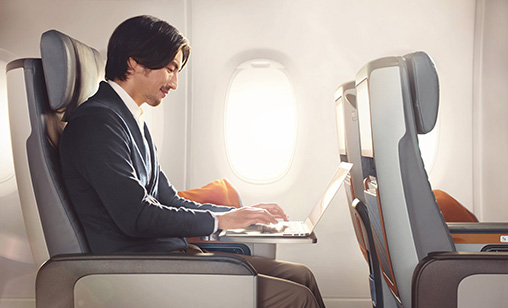Inflight Entertainment
IFE connecting to the world on a 24/7 loop
Inflight connectivity and access to Wi-Fi for the internet and email is a booming business. New satellites and technological advances are breaking down barriers from past gaps in sky high communications. Very soon air passengers will be able to login however high you are flying and wherever you are in the world. Associate editor and chief correspondent, Tom Ballantyne, reports.
April 1st 2024
In early February, Intelsat, one of the world’s largest integrated satellite and terrestrial networks and a leading provider of In-Flight Connectivity (IFC), completed historic test flights to the Arctic Circle that demonstrated airlines requiring inflight internet connectivity on long-haul flights at extreme northerly latitudes - the Polar Routes - can access low latency, high-throughput service at any point on their route maps. Read More »
It was a historic result because airlines and their passengers have never had access to polar connectivity. The test flights were completed on Intelsat’s test aircraft, a CRJ-700 regional jet equipped with an Electronically Steered Array (ESA) antenna. Intelsat and Ball Aerospace engineers collected data necessary to understand the ESA’s operations and connections with different satellite orbits at different latitudes.
 |
How soon will access to connectivity be available for long-haul carriers such as Cathay Pacific Airways, Japan Airlines and Air India, carriers that operate from Asia to North America on Polar routes? “Very quickly,” said Intelsat regional director airline sales for the Asia-Pacific, Nicholas Silvestor,
“This is a key part of our product offering now. We call it a multi-orbit strategy. As well as utilizing the Intelsat geostationary satellites (GEO) situated around the equator, we are integrating a lower orbit network into our service offering. The lower earth orbit (LEO) satellites rotate in a different direction around the world. Utilizing GEO and LEO gives us true global connectivity, including the polar routes.”
The ESA antenna is a critical development in the sector, he said. “In order to utilize this multi-orbit LEO and GEO you need an electronically steered antenna that can switch very quickly between satellites and handle handovers that are happening literally every few minutes, he said.
“The new ESA is a lot smaller in height which brings significant operational benefits. It is lighter. It is easy to upgrade or retrofit. It is a new era of satellite connectivity as the new equipment can deliver it,” Silvestor said.
“We have been testing this service for about 112 months with our demo aircraft with very successful results over the Artic. Multi-orbit technology offers a seamless service to any aircraft in any position.”
Intelsat’s service is available on Cathay Pacific, Japan Airlines, Virgin Australia and some flights on Australian regional airline, Regional Airlines (Rex).
It is a competitive market. Singapore Airlines providers are SITAONAIR and Panasonic. Malaysia Airlines uses Panasonic. Emirates Airline is with Inmarsat. Qantas uses ViaSat’s global Ku-band network and NBN’s (National Broadband Network) SkyMuster high-capacity Ka-band satellites to provide IFC connectivity, but only over Australia.
Even with the technology being introduced into the sector, it is still a complex market. Singapore Airlines, for example, advises passengers Wi-Fi is not available over India, Iran and Turkey because of “regulatory issues”.
A similar situation exists over China where providers can utilize GEO satellites but not LEO satellites unless they have a Chinese partner “There are certain jurisdictions, China included, where there is a requirement to land the satellite signal in the country. Therefore, you must have a local partner there,” Silvestor said.
“Intelsat does. We can operate over and into China. But some of the lower orbit operators, new entrants to the market, do not have that access so their services will be prohibited. It is another good example of [the value] of multi-orbit. We can switch to the LEO network as the aircraft approaches or is over China.”
Does Intelsat have any Chinese customers? “In discussion. Cathay Pacific is a good example. Let’s leave it there,” he said.
The economics of providing inflight connectivity onboard are improving, although it is more about airlines emerging from the pandemic and differentiating themselves by being closer to customers. “Connectivity is a great way to do that. Airlines are certainly picking up on that,” he said.
“We are in some kind of discussion with pretty much every airline in the region. Different airlines offer different Wi-Fi connectivity to passengers. Often free Wi-Fi is not available for entire flights. Or airlines might provide free Wi-Fi access only t premium passengers.